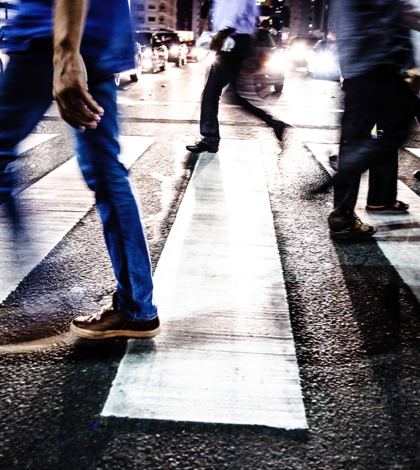Plans call for a two-mile stretch of Sixth Street to be narrowed and turned into a pedestrian-friendly shopping district and gathering place. Funding could be a challenge, but the transformation will help existing businesses and possibly attract new ones.
If all goes as planned, Corona could have a restored downtown in two or three years, one that has an improved traffic flow and is more accommodating to pedestrians and bicycle riders.
It all depends on financing and whether the economy holds up, said Jason Moquin, senior planner for the city and a member off Next-Gen, a team of staff members that put together a downtown restoration plan.
That plan, which Next-Gen presented to the city council last November, would narrow the traffic flow on Sixth Street to one direction each way and would bring diagonal parking to that thoroughfare, Moquin said.
The new parking arrangement would be better for businesses, especially restaurants, because it would make it easier for people to get in and out of downtown, Moquin said.
Other improvements would include off-site parking, decorative street lighting, outdoor seating, wider and better-paved sidewalks, drought-tolerant landscaping, an art wall and a city monument.
Bollards – the short, removable posts used to block or divert traffic – will be installed so that street fairs and possibly another Farmers Market – the city already has one – can be held along Sixth Street, according to the plan.
The city’s goal is to create a place where people want shop and eat, but also a place where people want to hang out for an hour or two and just relax, City Manager Darrell Talbert said.
Done correctly, the revitalized downtown would attract more businesses, create more jobs, increase taxable sales and stimulate more private investment in the city, according to Next-Gen, which spent about four months putting the Circle City Gateway downtown beautification plan together.
“Fixing our downtown is the one thing we have left to do,” Talbert said. “It’s a big project, but it has to be done. I wish we still had redevelopment to work with, but I think we can do a lot of the work ourselves.”
Construction on a two-mile stretch of Sixth Street between East and West Grand Avenue – Grand Avenue runs in a circle – cannot start until after 2017, when Caltrans finishes improvements to the nearby 91 Freeway.
Work on improving downtown will be done one block at time, with each block costing $400,000 to $600,000. Corona will use state and federal grants to pay for its downtown renovation, along with money from its capital improvement funds and any other funding sources it can come up with, Moquin said.
“The idea is to start at the core of downtown and work our way out from there,” Moquin said. “When it’s done it will be a genuine downtown corridor with an entirely different feel to it than what is there now.”
Corona officials have been considering an overhaul of downtown for years, as the area lost its appeal and businesses there began to struggle. That undertaking became even more difficult in 2012 when, in a budget-cutting move, the Brown Administration eliminated redevelopment.
Without redevelopment, California’s cities and counties no longer have the tool they once had to get control of private property and convert it to public use.
For example, Corona’s redevelopment agency could have gotten the parcels needed for the planned offsite parking downtown, with redevelopment but now the city must find other ways to get those properties or proceed without them.
“There’s no question this project got a lot more difficult when they did away with redevelopment,” Talbert said.
But reviving a downtown is difficult even in the best of circumstances. Funding must be secured, a plan must be reached that a majority of the public and private sector agrees on and a timetable must be worked out.
Finally, businesses must be persuaded to locate in an area that hasn’t been friendly to businesses for awhile, a risk that a lot of business owners aren’t willing to take.
However, if done correctly – Old Town Pasadena or the Gaslamp Quarter in San Diego – the social and economic rewards can be immense and long lasting, said Bobby Spiegel, president and chief executive officer of the Corona Chamber of Commerce.
“What we need is a pedestrian-friendly area where people can not only shop but also relax and enjoy themselves,” Spiegel said. “I think that’s what this plan will give us.”
The Circle City Gateway plan represents a return to the downtown Corona of the early to mid-1970s, when the area was “like an outside mall” and more of a downtown shopping destination, said Spiegel, who has held the chamber’s top administrative position since 2001.
But Galleria at Tyler opened in Riverside in 1970, and over time that indoor facility put a dent into downtown Corona’s retailers. Much of the same thing happened to the Pomona Mall at that time, which saw its traffic count drop after the Montclair Plaza opened in 1968.
That was the era when large indoor shopping malls became the rage and downtown, outdoor shopping fell out of favor, a trend that has now reversed.
Corona’s latest downtown plan stands a good chance of succeeding because it’s designed to make it easier for pedestrians to move around, the one thing any downtown must have if it’s to work as a shopping destination, Spiegel said.
“As long as it’s pedestrian friendly then it should become a go-to destination,” said Spiegel, Corona resident for nearly 60 years and the one-time owner of a downtown floral shop. “If you don’t have that, it’s never going to work.”
One current downtown business owner says he’s pleased to see the city has come up with a downtown restoration plan, but added that he’ll be skeptical until he see some results.
“I’ve been here too long and I’ve heard too many downtown renovations plans, so I have to be a little reluctant,” said Paul Kim, owner of SGC Sushi Restaurant at 113 E. 6th St. “But I’m glad they’re doing something. Only about five or six of the restaurants here generate any foot traffic.”
 IE Business Daily Business news for the Inland Empire.
IE Business Daily Business news for the Inland Empire.


